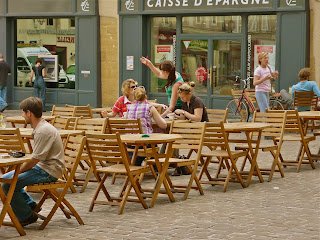
Depicted above is a Merovingian sword. The Merovingians were a Frankish tribe, in other words a Germanic conglomeration whose descendants are, among others, the German and French nations we know today. Only chieftains carried such long swords while their thegns (followers / warriors) swung axes and stabbed their foes with a type of knife (a short sword actually) called the "scramsaxe". The origins of the first and most powerful European dynasty to emerge from the ruins of Rome are thus Germanic.
I recall the winter of 1980 walking a suburb of Bonn called Bad Godesberg with my German host-mother Ingrid. As we passed the window of a bookshop, a book titled "Kulturen im Norden" (Cultures of the North) immediately caught my attention. The book deals with the origins of Germanic, Celtic, and Slavic tribes of northern Europe and was a translation from the original English (Wilson and friends). I was pleasantly surprised that following christmas when I unwrapped a gift to discover it was that book. Ingrid had given me a very personal present indeed. The details surrounding the origins of the Franks are long and tedious and perhaps boring for most but I find them totally fascinating! This was 1980, I was 17, no Dan Brown or Da Vinci codes and no Holy Blood Holy Grails by Baigent and consorts; there I was into German history and the Merovingians as a Mexican from L.A. living in Germany.
Who were these people called the Franks who eventually gave rise to Clovis and Charlemagne under two dynasties: Merovingians and Carolingians? Without Rome there wouldn't have been any Franks as they were an alliance of different but related Germanic groups from the region east of the Rhine roughly located in the area that extends from the Ruhr river in the north, to the Sieg river further south. Today this area is formed by the Ruhr river region (recently one of the most important industrial areas of the world), and a bit further to the south the Bergisches Land which translates literally into mountain country. It is roughly the area that borders the right banks of the Rhine opposite Cologne and Bonn. It is believed that the Franks arose from a tribe knows as the Sicambrians and / or the Ripuarians (among other allied ethnicities most likely) which lived in this area during the late imperial period. They evolved a strong cultural identity (ethnos) and cohesiveness only vis-à-vis Roman occupation as would be expected in acts of resistance.
The Romans themselves would not have classified them as a "nation" in the classical sense of the word, but because Roman civilization, just across the river Rhine in Cologne for example, provided such a strong impetus for trade and intercultural exchange, that force alone was sufficient enough to rally these people (Völker) under the sword of leaders. These leaders, heroes in the eyes of their followers, paved the foundation to what became European nobility.
The ancient and beautiful city of Metz was a major stronghold of Merovingian culture and the craddle of the Carolingian dynasty, one of whose founding fathers was bishop (now a declared saint) Arnulf, an ancestor of Charlemagne. He is known in German history as Arnulf von Metz but in the Romance language of the French as Saint Arnould. Provincial Roman aristocracy (senatorial clans), who had adopted Christianity and occupied the bishopric as a political mechanism of administration (people control) fused with Frankish warhorses to evolve into what became European "noble" dynastic lines. Their descendants still live among us and exercise major influence on world events.
















